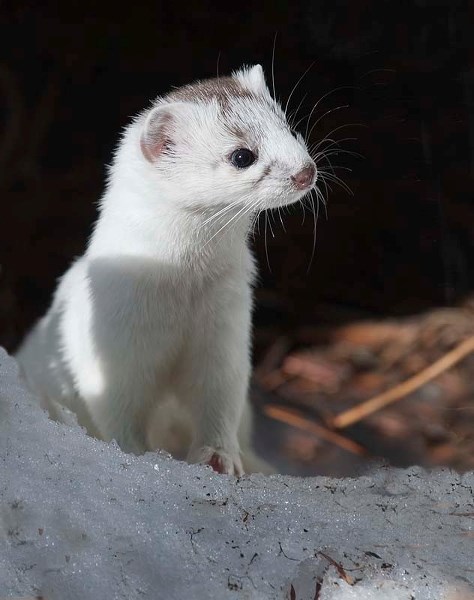Weasels are fearless. Just ask Leah Kongsrude, St. Albert's environment and sustainability manager. She says she had to camp out in an old radar bunker near Churchill, Man.
Weasels are fearless.
Just ask Leah Kongsrude, St. Albert's environment and sustainability manager. She says she had to camp out in an old radar bunker near Churchill, Man., once during her student days, and shared the space with a bunch of wild short-tailed weasels. "They're really energetic and curious and really cute."
They were also really irritating, as they'd spend every night crashing about inside her propane stove rummaging for leftovers. She'd yell at them and wave her flashlight to spook them off. "As soon as I'd flash my flashlight, he'd pop out of the stove and look at me." After which, of course, they'd sort of smirk and carry on with what they were doing.
"They weren't really afraid of us at all."
Weasels are long, furred, agile predators with short legs, beady eyes and pointy noses. Often brown in the summer, they turn white for the winter.
There are three weasel species that frequent the St. Albert region, says Harley Coleman, a retired pest management officer in Morinville.
You're most likely to encounter the short-tailed weasel, which has white feet and a black tip to its tail.
Much less common is the long-tailed weasel, Coleman continues, which is usually about 45 centimetres long (reports Alberta Environment). "The tail is about a third of the length of the body," he notes, with the black bit being about an inch. Unlike the short-tail, these weasels have brown feet, and are considered to be potentially at risk in Alberta.
"The least weasel is just a little guy," Coleman says – about 20 centimetres long, reports Alberta Environment, or about 13 less than the short-tailed. "They can go anywhere a mouse can go," he notes, which makes them effective hunters. Unlike the short and long-tailed weasels, least weasels do not have black tips to their tails.
You're most likely to find a weasel around Big Lake or in ravines, Coleman says, hopping about in search of food. Most will be curious of you when encountered, although some might chatter aggressively if you're intruding on their lands. "They'll come up to you and give you the dickens."
Killing machines
Weasels hunt a long list of animals, reports the Montana Trappers' Association, including mice, rats, voles, chipmunks, birds, frogs, bats, bugs, worms and domestic chickens. They'll even hunt hares, which can leave them hanging on to their prey's neck as it runs away.
Bogaert recalls one ludicrous incident where a short-tailed weasel tried to make off with a deer he was in the process of gutting. "It was just tugging on it and tugging on it," he says. "That's how feisty they are."
Weasels are capable and aggressive hunters possessed of speed, sharp senses, and a drive to search every nook and cranny, Coleman says. "They can catch a red squirrel quite readily," he notes, and cross Highway 2 in about one second. They're so fast that they often strike before they're even noticed, delivering a fatal bite to the back of the head or the jugular vein.
Even when they are caught, say by a hawk or owl, weasels are still feisty enough to fight back. Coleman recalls one time years ago when a marsh hawk swooped down and grabbed a short-tailed weasel maybe 30 feet from him. The weasel retaliated, biting at the bird's legs until it had no choice but to let him go.
Thing was, that happened at about 250 feet up. "The drop didn't hurt him a bit," Coleman says of the weasel, but he's not sure what happened to it afterward.
Weasels will stockpile food in times of plenty, Coleman says – he's found mice and voles stacked neatly like sardines in many a weasel's den. "They're good mousers," he says, and help keep the rodent population in check.
They sometimes get a little carried away with the murder, though, especially if they get into a chicken coop. "They'd just go on a frenzy of killing," he recalls from his pest-control years, slaughtering about 50 chickens in a day.
You're more likely to see a weasel's tracks than the actual weasel, Bogaert says. "To see one, it is a lucky day." Look for groups of four tiny paw-prints spaced about two feet apart – a sure sign that a weasel has been hopping by.
If you do see one, he continues, it will invariably surprise you, as they are masters of stealth. He recalls one time when, while he was standing still during a hunt, a weasel managed to crawl halfway up his leg before he noticed. "The weasel is not afraid of anything."
Weasel (various)
Name:
Mustela nivalis (least weasel), Mustela erminea (short-tailed), Mustela frenata (long-tailed).
Appearance:
Long, thin, agile white (in winter) mammal with short legs, beady eyes, small ears and a pointed nose. Short-tailed has white feet and a black-tipped tail. Least weasel has no black tip. Long-tailed will have brown feet.
Commonly seen:
Bounding about near wooded areas or Big Lake.
Occasionally confused with:
Each other. Weasel species are very tough to distinguish at a distance.
Fun fact:
Short-tailed weasels can eat about a third of their body weight in a day.
Wild St. Albert
Like wildlife? So do we! Every second Wednesday the Gazette profiles a reasonably common wild creature in the St. Albert region. Birds, beasts, bugs, fish … so long as it's alive and kicking, we'll feature it. <br /><br />Got a creature you'd like to see profiled? Send your suggestions to [email protected].




